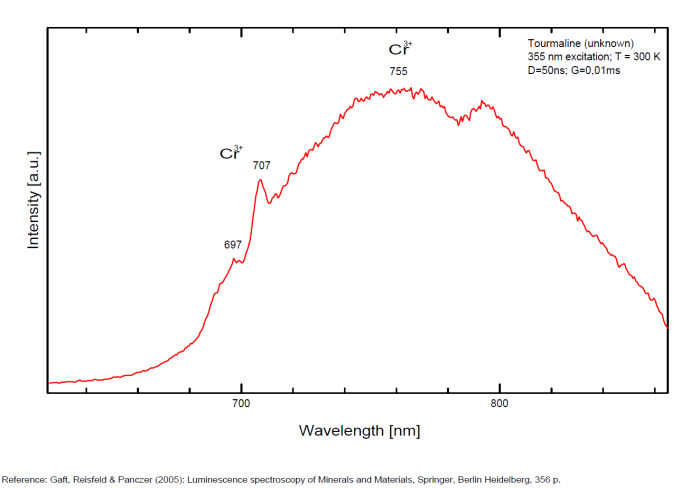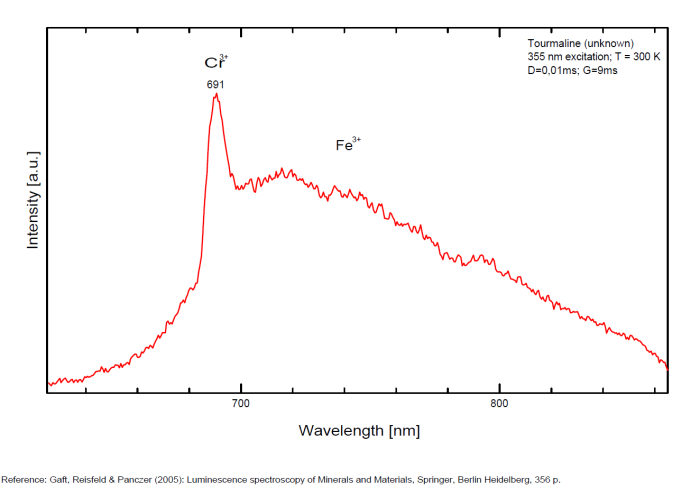Database of luminescent minerals
tourmaline
Chemical formula: See DRAVITE / (Group: see/voir ELBAITE, UVITE, DRAVITE)
Family: Silicates
Status: NR
Crystal system : Rhomboedric
Display mineral: NON
Luminescence:
Longwave UV (365nm) colors: |
Blue , Bluish White , sky-blue , | ||
Shortwave UV (254nm) colors: |
Blue , Bluish White , sky-blue , | ||
Daylight picture
Shortwave (254nm) picture

TOURMALINE;
UVSW
Photo and Copyright: James Hamblen
Site of the author
Used with permission of the author
Do you have a photo of this mineral you would like to see in the gallery? Contact us!
Phosphorescence (in the common sense of the term) observable with the naked eye:
No data
Activator(s) and spectrum:
Activator(s): Cr3+, Fe3+, Mn2+ ,
Peaks in the spectrum (nm):
Cr3+ : lines at 691, 697, 707 nm
Fe3+ : band at 700 - 750 nm
Mn2+ : band at 560 - 570 nm

Spectrum: Michael Gaft, Petah Tikva, Israel. Plot: Institute of Mineralogy, University of Vienna, Austria, with permission of the authors.
Spectrum Galery:

 ...
...Comments on spectrum and activators:
Under lamps excitation tourmaline is practically non-luminescent, while under X-ray excitation it exhibits impurity luminescence from Fe3+ centered at 700–750 nm and Mn2+ centered at 560–570 nm (Kusnetsov and Tarashchan 1988). (Gaft) Activators: Cr3+ (lines at 691, 697, 707 nm), Fe3+ (band at 720 - 750 nm), Mn2+ (band at 560 - 570 nm)
Best localities for fluorescence (*):
(*)The data are not exhaustive and are limited to a few remarkable localities for fluorescence
Bibliographic reference for luminescence:
- The Henkel Glossary of Fluorescent Minerals, Dr. Gerhard Henkel, Published by the FMS, 1989 ,
- Luminescence Spectroscopy of Minerals and Materials, M. Gaft, R. Reisfeld, G. Panczer, Springer Editor, ISBN: 10 3-540-21918-8 ,
Mineralogical reference on the Internet:
 http://www.mindat.org/show.php?name=Tourmaline
http://www.mindat.org/show.php?name=Tourmaline
 http://webmineral.com/data/Tourmaline.shtml
http://webmineral.com/data/Tourmaline.shtml
Internet Search:
 Image search on 'Google Images'
Image search on 'Google Images'
 Search for documents in all languages on Google
Search for documents in all languages on Google
A request providing no result means only that no such reference exists in the database, but it does not mean that what you are looking for does not exist, just not to our knowledge. If you think you have found an error or omission, please let us know via the contact page being sure to cite the source of information.


